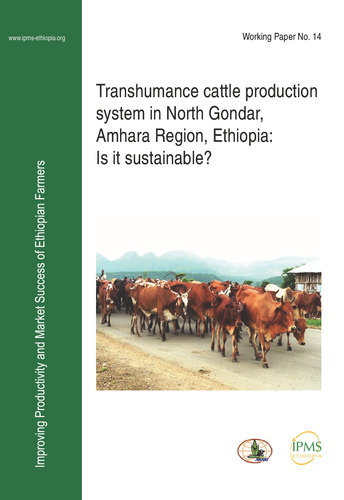Transhumance cattle production system in North Gondar, Amhara region, Ethiopia: is it sustainable?
Abstract
The study was carried out in three highland woredas (districts) of Chilga, Dembia and Gondar Zuria in north Gondar Zone, Amhara Region, Ethiopia. These woredas were purposively selected because of their long experience in transhumance cattle production system. The objectives of the study were to characterize the transhumance cattle production system, identify the major constraints and forward appropriate developmental interventions for the future. Informal and formal surveys were employed to collect qualitative and quantitative data. From these woredas, a total of 180 representative households from 9 rural kebeles were selected using systematic random sampling methods. Semi-structured questionnaires and topical guidelines (checklists) were used to collect data. The results revealed that livestock production system in the highlands is characterized by mixed crop–livestock production and rainy season transhumance production system. Transhumance production system was practised mainly into the lowland areas. The major reasons why cattle were trekked to the lowlands were availability of feed (99.2%), free land for stocking (92.4%), low disease risk (25.0%) and availability of non-waterlogged areas (0.8%). Preferred locations were Metema (84.0%), Armachiho (9.6%), and Quara (4.0%) woredas, while very low percentages considered Alefa and Chilga woredas (0.8% each). The months when cattle movement started were May (69.5%), June (29.6%) and April (0 .8%), and the months of returned home were October (45.8%) and September (35.9%). Three major cattle trekking routes were identified, and the selection of routes depended on distance, availability of forage and non-crop covered areas. The first destination is Agamwuha kebele (Lemlem Terara) in Metema district, irrespective of the routes followed. About 60.3% of the cattle population of the three woredas was trekked to the lowlands during the rainy season. The number of cattle owners and the size of cattle population involved in one group were 4.3 ± 0.18 farmers and 58.8 ± 3.89 heads, respectively. The average daily milk off-take, lactation yield and lactation length of indigenous cows in the three studied areas was about 2.0 ± 0.07 litres, 540 ± 21.05 litres, and 8.9 ± 0.16 months, respectively. The mean age at first calving (AFC) and calving interval (CI) was 5.2 ± 0.30 years and 19.0 ± 0.38 months, respectively, while mean calf crop was 7.4 ± 0.47 heads. The average weaning age of calves was almost one year, being 11.6 ± 0.26 months. In the lowlands, milking, butter making and selling of dairy products were performed only by male herders. In the highland areas, butter (95.6%) was one of the most important saleable dairy products followed by raw milk (18.4%), fermented milk (ergo) and buttermilk (6.1%). However, during the transhumance period, butter (95.3%) was the major marketable commodity followed by raw milk (61.3%), buttermilk (18.9%) and fermented milk (14.2%). Highlanders also market dry cows, oxen, heifers and young bullocks during their stay inthe lowlands. The major constraints identified by the highlanders were conflict with the lowlanders, cattle theft, human and livestock diseases, and lack of markets. Most of the respondents (86.3%) estimated that the trend of transhumance has been increasing due to feed shortage (50.4%), expansion of crop cultivation (27.4%) and increasing cattle population (21.2%) in the highlands. Human population has also been increasing both in the highlands and lowlands, and the current infrastructure development in the lowlands (tarmac road, electricity, phone etc.) will further encourage more migration to the lowlands. The conflict over resources will intensify, probably leading to the demise of this production system unless alterative development strategies, such as intensification of the production system in the highlands and development of feed conservation and marketing in the lowlands are devised.

